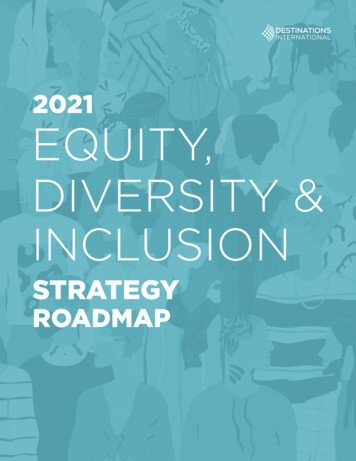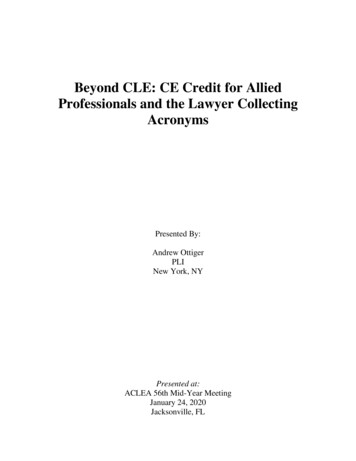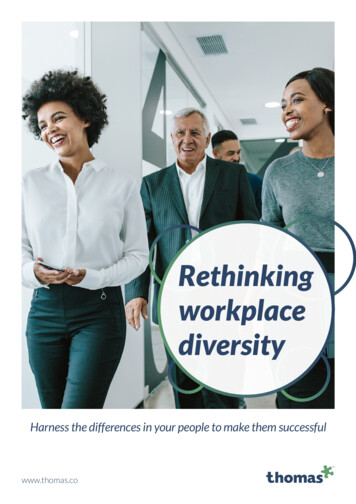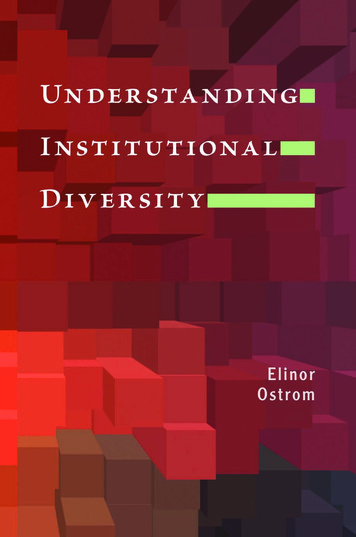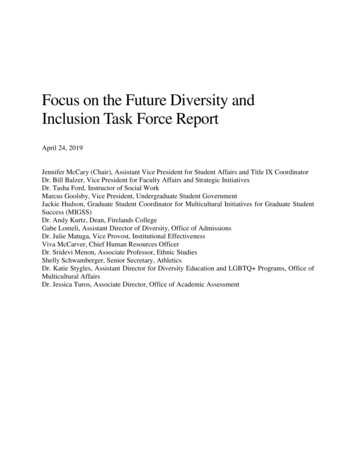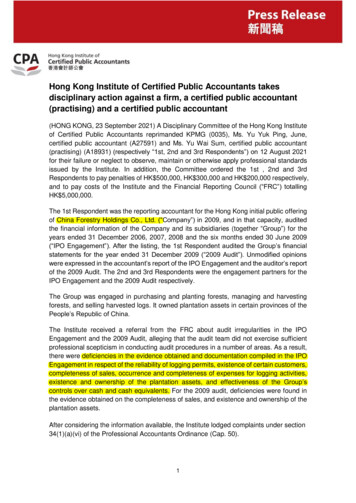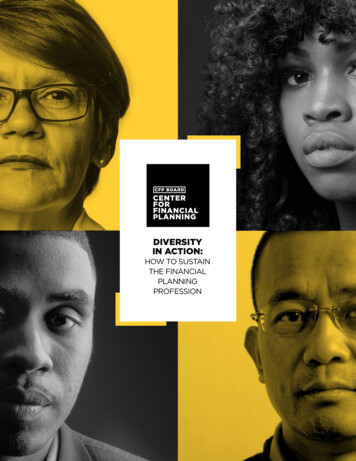
Transcription
DIVERSITYIN ACTION:HOW TO SUSTAINTHE FINANCIALPLANNINGPROFESSION
THE CFP BOARD CENTER FOR FINANCIAL PLANNING ISGRATEFUL TO ITS SPONSORS FOR THEIR GENEROUS FUNDING.2020DIVERSITYSUMMITSPONSORSPREMIER SPONSORMAJOR SPONSORSIGNATURE SPONSORSSUPPORTING SPONSORSCENTERFORFINANCIALPLANNINGSPONSORSLEAD FOUNDING SPONSORFOUNDING SPONSORS
WELCOMEKEVIN R. KELLER, CAECEO, CFP BoardD.A. ABRAMS, CAEManaging Director,CFP Board Center forFinancial PlanningThis year has challenged us all for a numberof reasons, from the pandemic caused byCOVID-19 to the effects of the nationalracial reckoning. In fact, the unprecedentedpandemic has highlighted the importanceof personal financial advice. It has beenso inspiring and uplifting to see firms andindividuals alike rise to meet the challenge ofincreased demand and to provide services toconsumers who need the peace of mind thatresults from sound financial advice.The financial planning profession is full ofopportunity, but barriers prevent us fromunleashing its maximum potential. We facean impending exodus of employees asthe financial planner workforce continuesto age and retire. And the profession’sunderrepresentation of women and peopleof color highlights the work required beforewe meet the opportunity to work with andempower women and communities of color,who are the demographic engine of thenation’s progress. Racial, ethnic and genderdiversity are crucial to the sustainabilityof the financial planning profession, butwe will only be able to court, recruit andretain people from these communities if weare intentional in our diversity, equity andinclusion (DEI) work. The national racialreckoning also presents an opportunity forthe profession to show up for people of colorand stand in solidarity with them.Since 2018, the Center has published twothought leadership pieces on racial andethnic diversity:1. Racial Diversity in Financial Planning:Where We Are and Where We Must Go,and2. Why Diversity Matters: How WorkforceDiversity and Inclusion AccelerateBusiness Success in Financial ServicesThis year, the “virtual” Diversity Summit isfocused squarely on action and real-worldimpact, with a theme of “Sustainability,”highlighting metrics-driven, long-term DEIinitiatives. This year’s thought leadershippaper is a compilation of a series of casestudies from a select number of firms thatoutline their current initiatives aimed at3
increasing racial and ethnic diversity and shareadvice on how others can replicate and scaleefforts to diversify their own workforces. Thepaper was authored by The Raben Group onbehalf of the CFP Board Center for FinancialPlanning with input from the DiversityAdvisory Group. This publication serves twopurposes:1. to showcase the work being done acrossthe financial planning profession; and2. to deliver scalable insights for readersto be able to replicate that workthemselves.The case studies underscore the need forindividuals, firms and the industry to transitionfrom talk to action. We are grateful to thefirms featured in this paper for sharing theirexperiences and advice. We are able to doall of this work with the support of our 2020Summit sponsors, starting with our premiersponsor Merrill Lynch, our major sponsorJ.P. Morgan Chase, our signature sponsorsAmeriprise, Edelman Financial Engines, andMorgan Stanley, and our supporting sponsorsFP Transitions, FacetWealth and Prudential.We also want to express our continued deepappreciation to the Center’s lead foundingsponsor TD Ameritrade Institutional andour three founding sponsors, NorthwesternMutual, Envestnet and the Charles SchwabFoundation.We invite all those invested in the future of thefinancial planning profession — including ourCFP professionals, our education partners,firms that employ CFP professionals, andother organizations and associations — to joinus in our continuing effort to attract and retainmore Black and Latino CFP professionals.KEVIN R. KELLER, CAECEO, CFP BoardD.A. ABRAMS, CAEManaging Director,CFP Board Center for Financial Planning4
TABLE OFCONTENTS3Welcome6Executive Summary11Diversity Advisory Group12Introduction14Case Studies14Northwestern Mutual22HoyleCohen Wealth Management28Merrill Lynch Wealth Management34Wetherby Asset Management44Fidelity Investments49Charles Schwab & Co., Inc.60Conclusion61About the Center63Glossary of Terms65Sources Cited5
EXECUTIVESUMMARYIt is imperative that the financial planningprofession work toward expanding anddiversifying the ranks of its professionals whocan meet the needs of increasingly diverseconsumers, especially as consumer demandfor financial advice grows amid the pandemic.As racial inequities are being exacerbatedby the pandemic and the United States is inthe midst of a racial reckoning, we must askourselves what we can do as individuals, asfirms, and as a profession to advance a moreinclusive and diverse society. Therefore, thispublication serves two purposes: to showcasethe work being done across the financialplanning profession and to deliver scalableinsights for readers to replicate.The case studies in this thought leadershippaper exemplify the success of best practicesacross firms of a variety of sizes and models.They highlight different tactics that havehelped these firms pursue a more diverse andinclusive workforce. More than anything, thecase studies demonstrate the importanceof co-creation in every diversity, equity, andinclusion (DEI) journey, strategy, and tactic. Infact, a 2016 Harvard Business Review articleby Frank Dobbin and Alexandra Kalev foundthe most common top-down efforts typicallygo wrong.2 The authors found that applyingthe following three basic principles yieldedconsistently positive results: engage managersin solving the problem, expose teams topeople from different groups, and encouragesocial accountability for change. This researchconfirms what our case studies show — thattactics focused on control are less effectivethan those that invite people to contribute.Below is a list of initial recommended stepsthat are building blocks for an organizationaljourney to develop an effective DEI strategy:TAILOR TO YOUR FIRMDetermine how DEI aligns with andstrengthens the firm’s mission and valuesso the work can be sustainable long term.The granularities are important.3DEVELOP A MISSION AND VISION STATEMENTCommit to paper why you are doing this as a firm,why it is important to you, and what your vision is.4ENSURE LEADERSHIP COMMITMENTThe prioritization of DEI work needs to comefrom executive management to underscoreits importance. Executives and senior leadersmust be authentically committed; invest theirtime in learning and education, along withaccountability; and ensure that sufficientresources are available for multi-year work.DEVELOP A STRATEGYCreate a strategy with goals and tactics thatsupport your mission and vision statement. Thesewill guide implementation plans and metrics.ESTABLISH AND TRACK METRICSBe clear about what success will look like.Based on your strategy, develop and track metricsranging from the demographic composition ofstaff to inclusion competencies in every employee’sannual performance review. Create and maintaina dashboard of these metrics and measures tosupport accountability at all levels.ENGAGE EMPLOYEESInvite feedback and contributions from allemployees across the firm. This creates buy-in,transparency, and trust, especially frompeople impacted by racism.5EVALUATEUse surveys and questionnaires that allowyou to evaluate where your firm stands andcreate a baseline, understand where thereis room for growth, and track progress.6
Once the above initial work is in process orhas been accomplished, firms can then buildout the infrastructure to support their DEIjourney. All firms, no matter the size, shouldand can start somewhere. Below are a fewtactics that can be scaled based on a firm’scircumstances:DEI Officer. Create the position of DEIofficer/manager/director which reports to thepresident/CEO of the firm. This role will serveas a leader, advisor, advocate, catalyst forchange, and institutional resource focused oninfusing DEI into all programs and activities,tracking progress toward these goals, andcommunicating progress to an engagedcommunity.Budget. Set aside a substantial financialcommitment that is earmarked for DEIincluding implementing best practices,improving trainings, and building externalpartnerships. Eventually, the budget shouldexpand to also make additional hires in theDEI office.6Councils/Task Forces. Ensure that thereis a body that can steward all of the DEIwork and that it reports to the CEO ormanagement so that there is leadership buyin. This also promotes social accountability.7Data. Collect and use demographic data as abaseline measure of where the firm is and toestablish where it wants to be. Identify andgather qualitative and quantitative data forall stages of the DEI work.Employee Resource Groups (ERGs). FormERGs — voluntary, employee-led groupsthat foster an inclusive workplace. ERGs cancontribute to organizational objectives andinfluence business decisions.8With this thought leadership paper, we alsoare sharing tactical best practices for whena firm is further along its journey. Standouttactics include:Competencies. Create and hold employeesaccountable for inclusion and equitycompetencies.Motivators. Provide incentives, such asawards in the form of financial resourcesor accolades, which can help motivateemployees to engage and maintain DEI work.Education. Offer continuous training andlearning opportunities for employees to shareknowledge and gain educational experience.Recruitment Strategies. Tailor metric-drivenrecruitment strategies to help targetoutreach and recruitment efforts.Mentorship. Develop mentorship programsto develop a pipeline of employees andincrease diversity at managerial echelons— on average these programs boost therepresentation of Black, Hispanic, and AsianAmerican women, and Hispanic and AsianAmerican men, by 9% to 24%.97
Prioritize retention. While it may be easyto simply focus on recruitment efforts fordiverse candidates, the failure to createan inclusive workplace culture where newemployees feel safe and empowered to bringtheir best selves risks lower productivity andhigher turnover rates. Investing in employees acceleratesdiversity and growth. Firms are only asstrong as their employees. Invest in youremployees today to reap the rewards later.Provided by Northwestern Mutual,HoyleCohen Wealth Management, MerrillLynch Wealth Management, Wetherby AssetManagement, Fidelity Investments, CharlesSchwab & Co., Inc., the case studies in thispaper underscore how these firms not onlyunderstand the business case for diversitybut have thrived because they embedded itso intricately in their work. Below are someof the lessons learned that are shared in thecase studies:Deliberate and intentional change fostercommunity, inclusion, and belonging.Intentional efforts can create an inclusiveenvironment for diverse employees. Buildingcommunity through ERGs, study groups, orspecial events creates unique opportunitiesto drive conviction and build confidence.They are also a clear demonstration of a firm’scommitment to creating a culture of inclusion.Many of these firms have been effective inenacting change within their organizationsbecause they were intentional in identifyingbarriers, creating solutions that addressthem, and holding leadership accountable forindividual behavior and firm-wide practices. Conduct an internal audit. Undergo aninternal assessment to better understandboth employee work culture trends anddemographics. This assessment provides abaseline of current workforce diversity aswell as a diagnostic tool moving forward. Communication and transparency areintegral to the DEI journey. Use thechannels of communication at your disposalto inform employees of resources availableto them and to raise awareness of initiatives. Formalize collecting input. Createopportunities to gather ideas, perspectives,and recommendations from those insideand outside of the DEI committee throughforums and events. Combat implicit bias. Provide unconsciousbias and inclusion training and implementinitiatives that cultivate inclusiveenvironments. Evaluate hiring pathways. Find ways toimprove the retention and professionaldevelopment of all employees by evaluatinghiring and promotion practices. Lean into technology where applicable.Use technical tools where they’re helpful anduseful — such as using machine learning forjob descriptions to ensure job descriptionsand requirements are inclusive and nonbiased. Foster allyship. Allies can play a critical rolein DEI efforts without placing the burdenon underrepresented communities, butthey need to realize that being an ally isan ongoing process. Foster a communityof allies by sharing resources to help thembetter understand how inequities canpermeate all facets of society.8
Track progress. Review existing policies toevaluate where you are supporting a moreinclusive environment and where you areinadvertently creating challenges. Insight around data helps preventassumptions. Couple quantitative datawith qualitative findings to understandhow these initiatives affect employees. Thishelps avoid biases or assumptions that canemerge from looking at the data alone.Develop internal tools and resources. Internalresources for employees with actionable tips,insightful examples, and convenient forms andtemplates can help strengthen opportunitiesfor recruiting, hiring, and retaining idealcandidates.Flexibility is crucial. The ongoing pandemichas affected many companies and movedmany industries, including ours, to the virtualspace. This global phenomenon underscoresthe importance of DEI work being flexible andadaptive to be able to address the peoplecentric challenges that have emerged. Whileit is tempting to respond to uncertainty andfinancial pressure by deprioritizing or scrapingDEI programs altogether, such decisions willbe a detriment to your organization in thelong run. DEI can be the means by which yourorganization not only survives this crisis butcomes out stronger and more strategic.10Field integration is key. Co-creation andshared ownership of DEI strategies areessential for sustainability.Support industry advocacy. Share internaldemographic data to track progress andinvite more peers in the industry to follow suit.Transparency and accountability will lead togreater recruitment and retention rates.Build and develop external relationshipsof support. Partnerships with influencerorganizations that are led by and serve peopleof color, professional associations servingpeople of color, and student associationscan help promote the career opportunitiesavailable to diverse pools of talent.Embed DEI into client strategies. ERGs havealso become a place where firms can testand inform the design of their products andservices. They provide insight into the utilityof programs for certain populations. Thesespaces can help identify gaps, inform clientstrategies, and better position a firm to servediverse populations.9
Support communities. Make a positiveimpact on the communities where youlive and work. Supporting communityorganizations serving local andunderrepresented communities can help afirm broaden both its diverse talent andclient pool.Listen to external assessments andaccolades. Assessments and awards fromorganizations with meaningful standardsfor diversity and inclusion allow firms theopportunity to learn how they are viewedexternally. These can help identify gaps,highlight opportunities for growth, andshowcase strengths.Recognize how the pandemic is affectingeveryone. Stress and anxiety havedramatically increased during the pandemic.This can exacerbate mental health issues,which, coupled with civil unrest, can make itchallenging for many to remain productive.Recognize this reality and highlight moresupport mechanisms to help employeescope.Small steps prepare us all for the giantleaps ahead. Embedding inclusive practicesinto all levels of decision-making to createand sustain long-term momentum takes timeand effort. While starting off a DEI journeymay seem daunting, small steps can help setthe foundation for a successful journey.10
DIVERSITYADVISORYGROUPCY RICHARDSON - ChairSenior Vice PresidentNational Urban LeagueRONALD J. ADAMSVice President of FieldDiversity & InclusionNorthwestern MutualCHARLES ADI, CFP Financial AdvisorBlueprint 360, LLCLOUIS BARAJAS, CFP Wealth & BusinessManagerMGO Private WealthDANIELLE BEYERPrincipalValor Equity PartnersMARGUERITA CHENG, CFP Chief Executive OfficerBlue Ocean Global WealthRIANKA R. DORSAINVIL, CFP ROBERTO FERNANDEZCo-CEOWilliam F. Pounds Professor2050 Wealth Partnersin Management & Professorof Organization StudiesMIT Sloan School ofManagementJAMIE-CLARE FLAHERTYDirector, StrategicInitiativesThe Obama FoundationKATE HEALYManaging DirectorGeneration Next,TD AmeritradeInstitutionalVALERIE KINGSenior Vice PresidentAriel InvestmentsPHUONG LUONG, CFP Financial PlannerJust Wealth, LLCSAMUEL PALMERManaging Director,Head of BusinessDevelopment & StrategyChase Wealth ManagementJP Morgan ChaseGARY ROZIERManaging DirectorOak Street Real EstateCapitalLESLIE TABORManaging Director ofBusiness Consulting &Education—Advisor ServicesCharles Schwab & Co. Inc.KARA UNDERWOODHead of WealthManagement,Diversity & InclusionMorgan StanleyRENÉ NOURSE, CFP PresidentUrban Wealth Management11
INTRODUCTIONThe CFP Board Center for Financial Planning(Center) seeks to create a more diverse andsustainable financial planning professionso that every American has access tocompetent and ethical financial planningadvice. Over the past three years, the Centerhas published original research11 and literaturereviews that explore the barriers, root causes,and potential solutions to the significantdiversity gap in the advisor workforce.Previous thought leadership papershave presented findings, examined theirimplications and recommended researchbased actions for increasing diversity in theprofession. This year, the Center has decidedto focus on the sustainability and replicabilityof these initiatives. This paper presentscase studies from select firms that outlinetheir current initiatives aimed at increasingrepresentation within their walls, and,perhaps more importantly, how others canreplicate and scale these efforts to diversifytheir own workforces.Greater diversity, including race, ethnicity,gender, and sexual orientation, is crucial tothe sustainability of the financial planningprofession due to the shifting demographicsof the country. The business case fordiversity has been proven endlessly. Diversityleads to stronger sales revenue, customergrowth, greater market share, and higherprofit levels. We know this. We have allseen how diversity leads to stronger overallfinancial performance. The case studiesin this paper underscore how these firmsnot only understand the business case fordiversity but have thrived because theyembedded it so intricately in their work. Formany of the firms we highlight in this paper,DEI strategies do not exist as standaloneinitiatives but instead are threaded into theiroverall strategy, and many of them attributetheir employees’ and customers’ satisfaction,innovation, and financial growth to thisdeep integration.12
Of course, this has not always been the casefor our sector. For years, the industry hasbeen complacent in maintaining the statusquo. Systemic racism and oppression canbe so pervasive that, whether the result ofconscious or unconscious actions, they havedeprived people of color of the opportunityto build generational wealth. The recentsocial uprisings against systemic racismdemonstrate how these issues continue topervade all aspects of society today.Many in the sector that have upheld thestatus quo in the past are now choosing toacknowledge their complicit behavior andenact measures to address inequalities anddiscrimination. They have implementedpolicies and measures designed to enhanceopportunities for employees who havepreviously been impacted by these issuesand provide opportunities for more peopleof color, women, and other traditionallymarginalized individuals to see the financialplanning profession as a viable, inclusive, andbeneficial career.In 2015, CFP Board recognized that to addressthe lack of racial diversity in the financialplanning profession specifically, it neededto craft solutions to address root causes,beginning with establishing the Center. Manyof these solutions have already resulted inpreliminary gains. The number of Black andHispanic CFP professionals grew 12% lastyear — the highest increase ever, accordingto CFP Board. Despite last year’s gains,there are still only 3,259 Black and HispanicCFP professionals in total — less than 4%12of the 87,78413 CFP professionals versusnearly 30% of the country’s population.Especially within the context of the pandemicand the national racial reckoning spotlightingracial disparities, the absence of diversity isfelt in our everyday lives. Our current historicalcircumstances present an opportunity for us toask ourselves what we can do as individuals, asfirms, and as a profession to advance a moreinclusive and diverse society.BLACKS AND HISPANICSACCOUNT FOR NEARLY30%OF THE U.S. POPULATION,YET THEY MAKE UP LESS THAN4%OF THE COUNTRY’SCERTIFIED FINANCIAL PLANNER PROFESSIONALS.Against that background, this publicationserves two purposes:1Highlight a compilation of case studiesthat illustrate sustainability throughmetric-driven accountability2Deepen the industry conversation fromtalk to action by providing concreteexamples of successful DEI programs in awide range of financial services firmsWe want to note that each firm uses slightlydifferent language to describe their effortsand the demographic data they measure.This is reflected in the case studies below. Fora more detailed explanation of terminologyused in this paper, see the glossary on page 63.13
CASE STUDY1NORTHWESTERNMUTUALNorthwestern Mutual was founded in1857 on the simple premise that as amutual company, its sole focus is tomaximize value to its policyownerswhile doing what’s best for them longterm. Headquartered in Milwaukee,Wisconsin, the AAA-rated company isrepresented by over 9,000 financialprofessionals helping more than 4.5million clients achieve financial security.This case study focuses on the firm’slong-term Diversity & Inclusion vision, aswell as the strategy to integrate it intoits network and district network officesacross the United States.14
NORTHWESTERNMUTUALChampioning DiverseAdvisors AcrossNorthwestern MutualOver the past eight years, NorthwesternMutual (NM) has made significant progressadvancing its long-term diversity andinclusion (D&I) strategy. This comes againsta backdrop of challenges for financialservices firms. Data from CFP Board andthe Bureau of Labor Statistics14 affirmswomen and people of color are severelyunderrepresented in the industry —women, African Americans, and Hispanics/Latinos represent only 33%, 8%, and 7% offinancial advisors respectively. In 2012, NMunveiled details of its commitment and a15-year roadmap aimed at driving a moreinclusive culture for its employees, fieldrepresentatives, and communities.Northwestern Mutual’s vision is to be a worldclass company driving results through aninclusive culture, where its employees staywith it because it values them, and togetherthey make a difference in peoples’ lives. Thisvision is grounded in the company’s longheld mutual values and focus on doing rightby its people and policyowners.NORTHWESTERN MUTUAL HAS SIX KEYFOCUS AREAS FOR D&I INITIATIVESACROSS THE ENTERPRISE:1GOAL SETTING TO DRIVE FOCUSAND ACCOUNTABILITY2EDUCATION TO DRIVE ACTION BYEMPLOYEES AND FIELD REPRESENTATIVES3GROWING DIVERSEPIPELINES OF TALENT4SUPPORT AND ADVANCEMENT OFWOMEN AND PEOPLE OF COLOR5PARTNERSHIPS WITH THE COMPANY’SGROWING ERGS AND D&I COUNCILS6COMMUNITY IMPACT TIED TO NORTHWESTERNMUTUAL FOUNDATION EFFORTS15
The following case study presents how NMis executing on its strategy to improve theexperiences of diverse advisors and supporttheir advancement in the field. NM has asimilar strategy for its corporate offices butthis case study focuses specifically on thework the company is doing in the field.With input from its D&I Councils and FieldD&I Committee, the company has launchedand invested in meaningful initiatives toadvance racial and gender equity to take NMacross the phases outlined below.From Company-ledInitiative to Galvanizinga MovementEnterprise D&I efforts led from the topmust be sustained by grassroots leadershipand initiatives that engage employees atall levels to take action. To this end, NM’sD&I efforts are aimed at galvanizing allindividuals — leaders, employees and fieldmembers — to be part of the learning anddialogue and take personal accountabilityfor shaping an inclusive culture.16
Gender EquityNM has historically invested in efforts toadvance women across the company,including the growth of women financialadvisors and leaders, through a largelycorporate-led approach. The companywas seeing incremental progress, but thesentiment was that the work could not movefast enough.The turning point began three years agowhen NM convened a Gender Caucusto bring together senior leaders of thecompany with influential leaders andadvisors from the field, both womenand men, to discuss what barriers werepreventing attracting, retaining, and growingthe number of women in the field.The result was an increase in the level ofconviction and a deeper understanding ofthe unique barriers women face in financialservices, and clarity on actions neededto change the trajectory for women’sadvancement at the firm.A glaring point was the lack of womenrepresented within NM’s Field Associationsystem. Field Associations work with theHome Office through field committees.The Associations offer opportunitiesfor members of each Field Committeeto collaborate with the home office oncompany projects and initiatives. The lackof women among the representatives onField Committees inadvertently limitedthe company’s point of view on prioritiesimportant to its field force.Based on those findings, the companymade the decision to invest in launching aWomen’s Field Association (WFA) to partnerwith the other Field Associations and theHome Office to provide input on companypriorities. The WFA was built by and for thefield to create three important assets for thesystem: (a) a self-driven women’s advocacyarm, (b) a mechanism for communicatingdirectly with women on issues importantto them, and (c) a community for growth,development, and relationship building.To complement this work, NM focused oncreating programs and initiatives designed toachieve the following key outcomes:Retain women already in itssystem through targeted supportand culture improvementIncrease representation ofwomen in leadershipShine a spotlight on a wider poolof women in the systemBuild a community and investin caucus spaceGalvanize individuals across theenterprise to take actionNM also developed guides and best practicesto help women advisors and field leadersnavigate the business challenges aroundfamily planning, such as short-term disabilityincome coverage, a return to work allowance,and a concierge of parental coachingservices.These examples are illustrative of the pivotsNM was able to make to advance its D&Istrategy beyond a corporate-led initiative toone that is grassroots and inclusive of thediverse groups it aims to serve.17
Racial EquityIn response to the racial gap in the industry,NM created a Sustainable Action for RacialEquity (SARE) task force to ensure that theirefforts were actionable and ongoing. WhileNM’s D&I work predates the creation of thetask force, Chairman, President, and CEOJohn Schlifske felt compelled to convenesenior leaders to gain a better understandingof the racial reckoning and to set up NM tobe intentional, consistent and impactful in itswork moving forward.The task force meets biweekly and is chargedwith creating a strategic framework toevaluate and leverage existing work at NMand identify new impactful opportunities toaddress racism and equity with a focus onthe Black/African American community. Thetask force is focused on the following aspectsof D&I work: Culture of Inclusion and Respect; Talent; Business Innovation and Financial Security;and Partnership and Community.are several incentives for hitting them;this approach is paying dividends as thecompany is halfway through the overallroadmap.An example of an incentive is the Diversity& Inclusion Champion Award. In its inauguralyear, the Diversity & Inclusion ChampionAward recognized offices that are making avisible impact in: creating an inclusive work environment; attracting and developing diverse talent; building a pipeline for growth opportunities;and engaging the diverse communities NMdesires to serve.The focus of this award is on progress,meaning every office regardless of size,location, or place in their D&I journey isencouraged to submit and compete forthe top honor. The top two offices wererecognized during the awards and honorsportion of the past annual sales meeting. Thewinning office received 30,000 to be usedin advancing D&I efforts in their office. Thesecond place office received 15,000.Dedicated TeamsNM’s Field D&I department is charged withsetting the standards, providing guidance,and informing the future direction of thework. The department plays a critical rolein prioritizing accountability and ensuringthat the firm is implementing its road map inoffices across the country.KEY TAKEAWAYThere must be a team focusedspecifically on D&I in the field. The D&Ivision can be the same at the corporateand field levels but there will benuances between the strategies used toimplement it that must be considered.Offices are then rated as part of theperformance management process andget support to help fill in any gaps. Whilemeeting the goals is not required, there18
Inve
consumers who need the peace of mind that results from sound financial advice. The financial planning profession is full of opportunity, but barriers prevent us from unleashing its maximum potential. We face an impending exodus of employees as the financial planner wo
